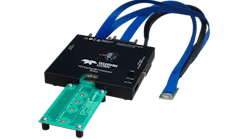When using the M.2 Interposer Card, coupled with Summit protocol analyzers, PCI Express (PCIe) bus traffic between a system board or tablet and a M.2/NGFF connector on a solid-state disk (SSD) can be monitored, captured, and recorded for protocol analysis. Teledyne LeCroy’s interposer supports analysis for all PCIe protocols, such as SATA Express (ATA/AHCI/PCIe) and NVM Express (NVMe) at 2.5 to 8 Gtransfers/s and lane widths of x2 and x4. The card supports both M.2 connectors—Socket 2 and Socket 3. Socket 2 (keyed as “B”) allows for PCIe x2 interfaces for SSDs, WWAN, or other non-storage devices. Socket 3 (keyed as “M”) strictly deals with high-performance storage, offering x4 lanes of bandwidth. In some cases, a “B/M” keyed SSD, which is both a Socket 2 and 3 type device, also will be available. A “B,” “M,”, or “B/M” keyed memory SSD can then be connected to a host-based B or M connector, which can support any of those three memory SSDs. Two versions of the M.2 interposer support all three memory SSD types: one is for use with B and B/M types, and a second is for M and B/M types. Both support 42-, 60-, 80-, and 110-mm SSD lengths.
Comments
